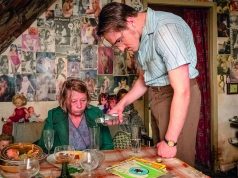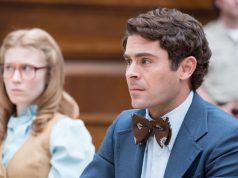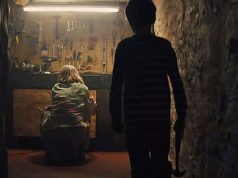Perhaps it’s fitting that “Zodiac,” David Fincher’s account of the notorious serial killer who eluded California police for more than two decades, should be as long and sprawling as the killer’s career. The frequent subtitles indicating how much time has passed since the previous scene (“2 weeks later,” “4 months later,” “3 years later,” etc.), combined with the film’s actual running time (more than 2 1/2 hours), give us a real sense of the size and scope of the investigation.
Perhaps it is also appropriate (and maybe even admirable) that we feel the same things the investigators do: excitement and curiosity at first, suspense about the killer’s identity … and then frustration over how much time is passing without any arrests being made. Fincher’s adherence to the facts of the case (as they’re presented in Robert Graysmith’s 1986 book, anyway) means that the film must end as unsatisfactorily as the real story did. We do get some closure — but it’s in the “what happened next” onscreen titles after the movie is technically over. It’s a terrible ending, both for the real story and the movie.
Yet it’s still a pretty watchable movie. Fincher’s usual frenetic editing and showy camerawork are absent — this movie looks nothing like “Fight Club” or “Panic Room” — leaving him to prove his worth as a storyteller in more mainstream ways. And he does it, too, handling multiple protagonists and 20 years of history with smooth, energetic confidence. If they’d ever actually arrested the killer, “Zodiac” would be a near-perfect genre film.
Jake Gyllenhaal plays Robert Graysmith, a clean-cut San Francisco Chronicle cartoonist in 1969, when the film begins. Two murders have just been committed in neighboring cities, and the Chronicle gets a handwritten letter from a man claiming to be the doer. He offers details that only the killer and the police would know, and he demands that a code he’s included be printed in the city papers the next day.
Graysmith is immediately fascinated by the case, even more so than the news reporter assigned to cover it, Paul Avery (Robert Downey Jr.), a drinker who’s every bit as loose as Graysmith is buttoned-down. They eventually become compatriots of sorts, though, with Graysmith offering insights that Avery hadn’t caught, eventually infecting him with his enthusiasm for the ongoing mystery.
Meanwhile, two San Francisco police inspectors, Toschi (Mark Ruffalo) and Armstrong (Anthony Edwards), are brought in when the killer — calling himself the Zodiac in his continuing series of letters to the papers — strikes again, this time in San Francisco itself. He appears to be murdering randomly, with different weapons and methodologies every time, which stymies the police force and terrifies the citizens. Toschi and Armstrong face not only the baffling nature of the case but also the bureaucratic headaches involved when a crime covers more than one jurisdiction: Vallejo police will give SFPD what they have in the way of fingerprints, but only if SFPD will turn over its handwriting analysis, which they’ll have to put in the mail because Vallejo doesn’t have a telefax machine, and so on and so forth. It’s a wonder any work ever gets done.
The film moves subtly from one central character to another, with Graysmith, Avery, and Toschi all taking the lead at various times. The transitions are accomplished so smoothly, in fact, that you don’t notice you haven’t seen Jake Gyllenhaal in a while until he’s been off the screen for a half-hour, and it always feels like they’re going to cut back to Robert Downey Jr. any minute now. It’s truly an ensemble film, with many characters appearing only once or twice before disappearing, their usefulness expended and there being no good reason to keep them around. Legendary lawyer Melvin Belli appears briefly, played by the great Brian Cox; later, Graysmith goes to Belli’s house to ask him a question, winds up getting what he needs from the housekeeper, and the scene is over before Cox can even show his face. A more ordinary director would have found a way to make that scene all about Belli, if only to give Cox more screen time.
Furthermore, James Vanderbilt’s dense screenplay deftly shows the nagging details that can throw a case off, the sort of details that are seldom included in fictional cop stories. We have a fingerprint left by the killer, except that maybe it was actually the doing of a clumsy cop at the crime scene. The handwriting expert (Philip Baker Hall) declares a prime suspect as not being a match, but there are some doubts regarding the expert’s reliability. Every piece of evidence that Graysmith brings up in his own research, Toschi can shoot it down, and vice versa. It’s maddening, and Graysmith in particular does start to go mad over it.
As a matter of fact, I daresay the film covers every major aspect of a crime spree such as this one: the effect on the investigators’ personal lives, the media coverage (“Dirty Harry” was directly inspired by Zodiac), the nutcases who come out of the woodworks, the copycats, the procession of false leads and near-arrests, the politics, the paperwork, the red tape, and the paranoia.
Which brings us back to the running time. To tell a story this far-reaching and complicated, you need a lot of time, and Fincher makes good use of it. But as an audience member, do you want to watch a film, even a good one, that runs 160 minutes yet finishes without a satisfying conclusion?
Basically, it comes down to this: This is probably the best movie that could be made about this case without completely fictionalizing it. The acting is unfailingly top-notch, and at various times the story is frightening, titillating, intriguing, and even comical. But it is never any of those things for very long, and when it’s over I can’t help feeling as disappointed as the cops must have been — which, again, might actually be a testament to the film’s proficiency. Maybe that’s the point, to make us feel exhausted along with Graysmith and Toschi. I admire the film, but I don’t love it.
B- (2 hrs., 40 min.; )





